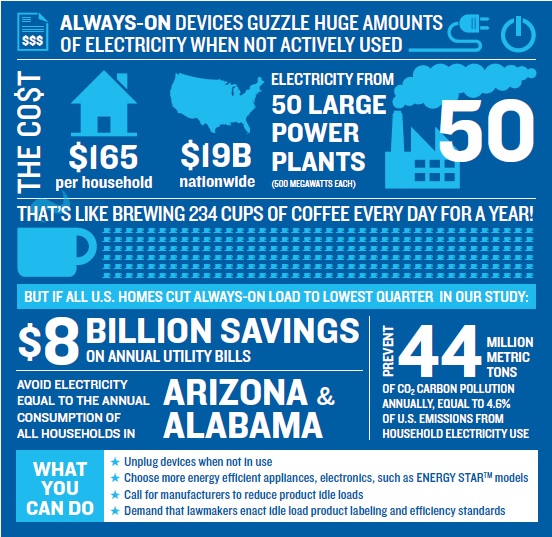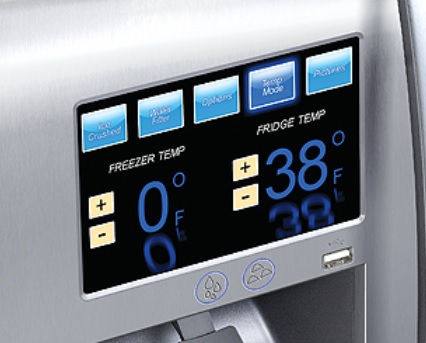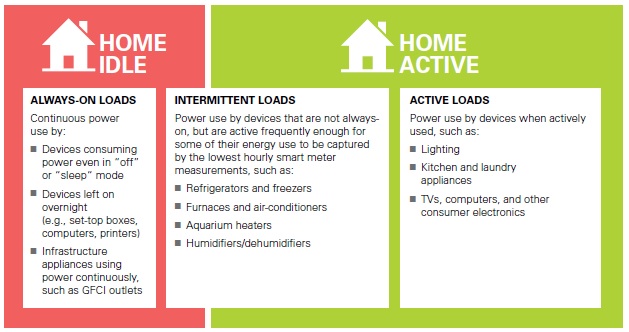It’s a staggering number, compounded by the fact that it’s actually rather simple to drive down. Approximately $19 billion worth of electricity in the United States is consumed by in-home devices that are always-on, or in idle states. When considering the growing number of devices that we’re bringing into our homes, though, perhaps it’s not all that unimaginable that we’d find ourselves in this situation.
The good news: there are easy fixes to really cut back on this idle consumption, and the even better news is that by doing so, we could effectively reduce the number of harmful pollutants and carbon emissions in our air.

The Natural Resources Defense Council (NRDC) recently released a report, entitled “Home Idle Load: Devices Wasting Huge Amounts of Electricity When Not in Active Use,” revealing the results of a major research study into the energy consumption habits of residents of the state of California.
That $19 billion figure – when broken down – is equivalent to the electricity output of 50 large power plants, and totals between $165 and $440 in electricity costs per household every year. Truth be told, the majority of the devices that are either hardwired or plugged into homes across America are consuming energy all the time, even when many consumers think they are turned off or not actively in use.
“One reason for such high idle energy levels is that many previously purely mechanical devices have gone digital: Appliances like washers, dryers, and fridges now have displays, electronic controls, and increasingly even Internet connectivity, for example,” says Pierre Delforge, the report's author and NRDC's director of high-tech sector energy efficiency. “In many cases, they are using far more electricity than necessary.”

The report listed the 10 worst culprits for always-on energy consumption, which included:
• Water recirculation pumps (annual energy bill cost estimated at $93)
• Desktop computers (annual energy bill cost estimated at $49)
• Televisions (annual energy bill cost estimated at $38)
• Cable set-top boxes (annual energy bill cost estimated at $30)
• Audio receivers/stereos (annual energy bill cost estimated at $22)
• Printers (annual energy bill cost estimated at $11)
• Furnaces (annual energy bill cost estimated at $8)
• Coffee makers (annual energy bill cost estimated at $6)
• Dryers (annual energy bill cost estimated at $4)
• GFCI outlets (annual energy bill cost estimated at $1 each)
Interestingly, the devices and appliances that many might think would be the biggest energy guzzlers were not the ones consuming the majority of household electricity. In fact, the appliances that we consider to be traditionally large energy users – such as home lighting, refrigeration and heating/cooling – accounted for only 15 percent of always-on home energy consumption. The ever-growing array of consumer electronics – including computers, televisions, gaming consoles, printers, and more – accounted for 51 percent, while other miscellaneous electrical load items (recirculation pumps, fish ponds, aquariums, and protected outlets in kitchens, bathrooms and garages) consumed the remaining 34 percent. The study also found that there was little fluctuation in these consumption figures based on the age of the home, and a limited correlation when taking into account the number of residents and the size of the homes studied.

This NRDC study represents the first large-scale research study to really investigate idle energy usage in homes, and was conducted in partnership with Home Energy Analytics and the Stanford Sustainable Systems Lab. The study reviewed three distinct data sets, including smart meter data from 70,000 northern California homes; smart meter and additional information for 2,750 San Francisco Bay Area homes; and a detailed in-home audit of 10 homes in San Francisco. For the purposes of this study, idle consumption is inclusive of devices in “off” or “standby” modes that are still drawing power, in “sleep mode” and ready to power up quickly, and devices that are left fully on but are inactive when not in use.
So, what can be done?
As alluded earlier in this article, the good news is that there are some practical steps that can be taken by energy consumers (ahem, all of us) to chip away at this shocking $19 billion figure. If all U.S. households took steps to reduce their idle consumption to the level that 25 percent of the homes in the study already achieve, we would collectively save $8 billion on annual utility bills, conserve 64 billion kWh of electricity use each year; and prevent 44 million metric tons of carbon dioxide pollution annually (~ 4.6 percent of U.S. residential sector carbon dioxide emissions) from electricity generation.
The NRDC also calls for action on the part of the manufacturers who are constantly evolving their products to include the “wow factor” of touchscreen displays and Internet-connected washing machines, but who don’t necessarily consider the incremental increases in energy consumption that these devices and appliances are generating. Utility company efficiency programs and more stringent statewide energy standards (such as setting maximum levels of standby power across devices) would also go far to make a dent in minimizing idle load and saving a large amount of consumer energy consumption.
“Consumers can take such steps to reduce their idle load as using timers, smart power strips, and changing settings on their devices, and manufacturers need to do their part by designing products to minimize energy waste, but ultimately policies like energy efficiency utility programs and standards are needed,” Delforge added. “Reducing always-on consumption is a low-hanging fruit opportunity to cut climate-warming pollution.”
The NRDC included an action guide to better educate consumers on ways to reduce their idle energy consumption, but some of the easiest tips for monitoring and reducing idle load include:
• Unplugging devices that are rarely used,
• Making better use of power strips and timers so that devices only draw power when needed,
• Adjusting electronic devices to automatically power down to the lowest power mode when not in use.
To view the full report, visit http://www.nrdc.org/energy/home-idle-load.asp.
Via Phys.org
Advertisement
Learn more about Electronic Products Magazine





